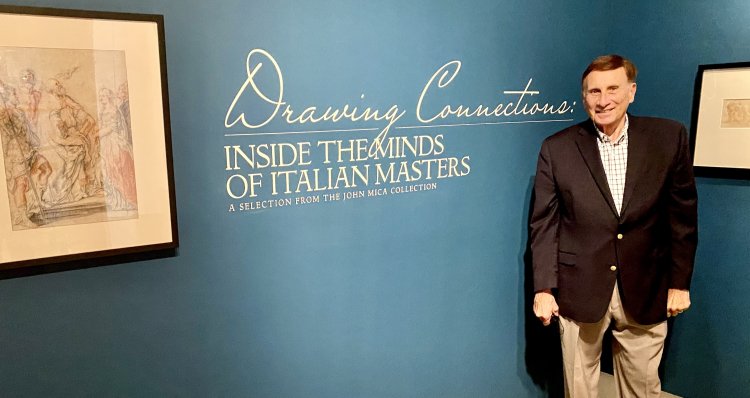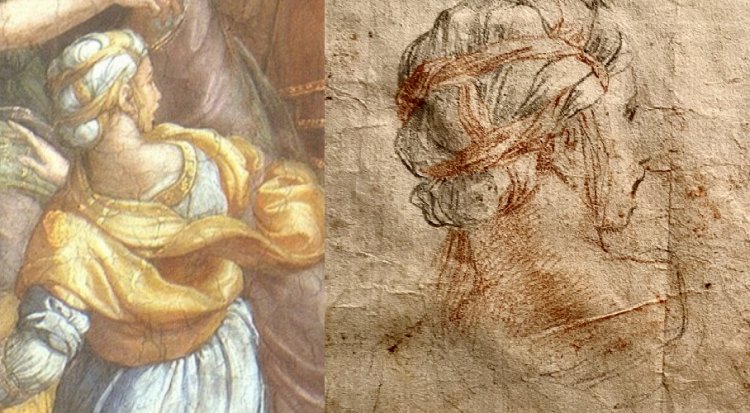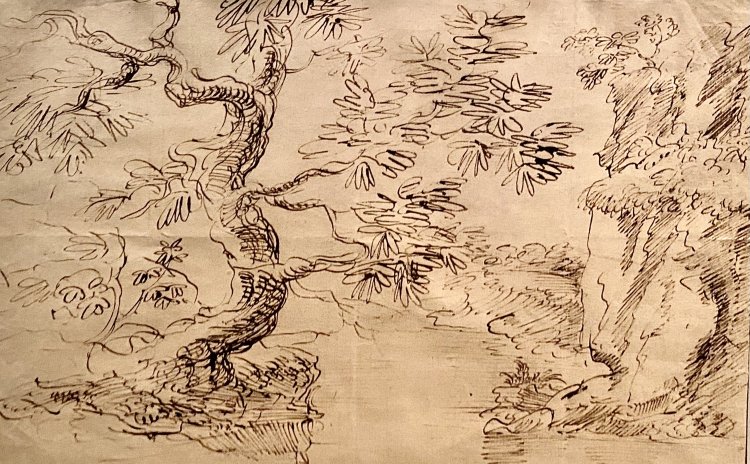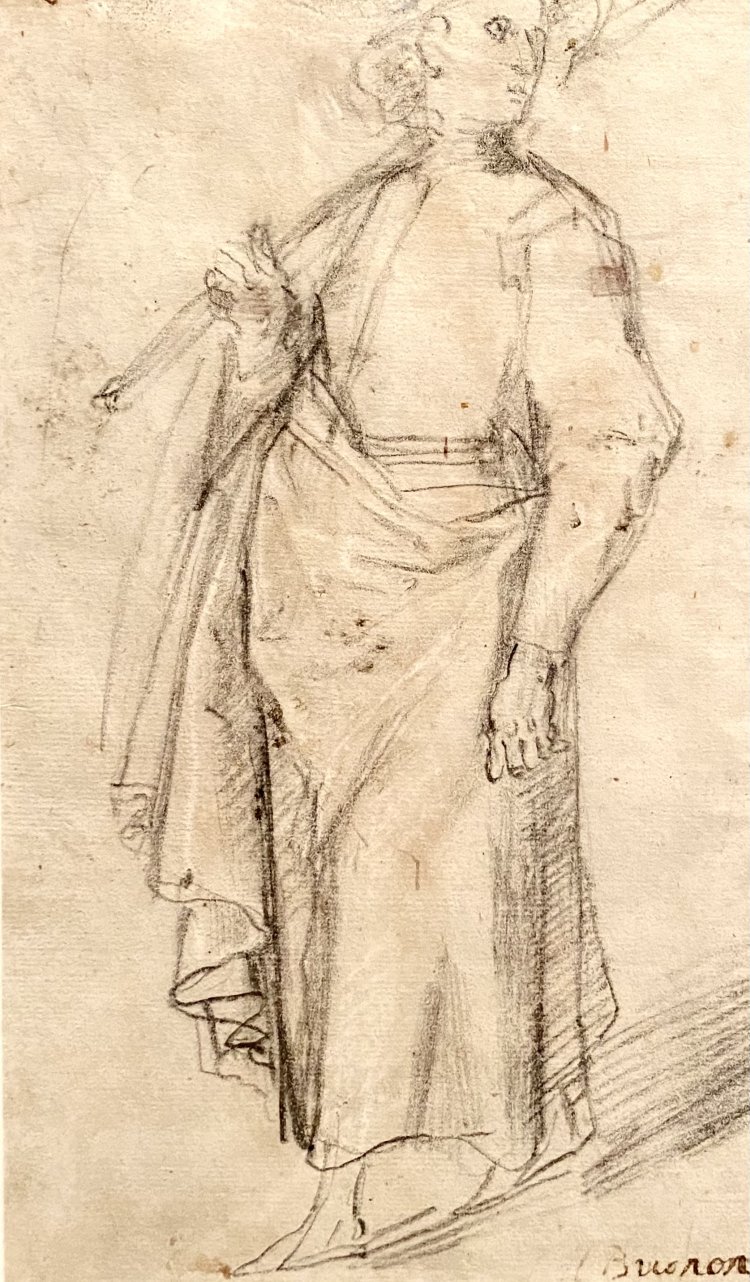Rollins' Cornell Museum Features John Mica Collection

“The good painter,” Titian once wrote, “requires only three colors: black, white and red.” Currently featured at the Rollins Cornell Museum of Art, the John Mica Collection contains many works invoking this color scheme drawn in ornate and fascinating ways. The Old Masters typically performed multiple steps of preparation before the first stroke of the artist’s brush. One such step concerned the production of sketches, including those on display at the museum.
The John Mica Collection encompasses drawings from the 16th to 19th centuries and displays these masters’ thought processes, working methods, and interactions with wealthy patrons. This special collection of rare sketches by icons such as Luca Cambiaso, Agostino Carracci, and Giovanni Battista Tiepolo will enamor art connoisseurs and provide exclusive insight into these artists' workshops and practices. Spanning the Renaissance, Baroque, and Neoclassical periods, the collection covers both secular and religious subjects. Figure studies, architectural sketches and landscape drawing compose much of the portfolio as well.

Pictured: Mica directs the groups attention to a Pellegrino Tibaldi sketch used as a study for "The Adoration of the Christ Child."
Burgeoning artists from all over the world flocked to Italy to hone their techniques by studying the methods the great masters employed. Sketching out their ideas on paper allowed artists to experiment with light, shadow, movement and decorative details. Artists went to extraordinary lengths to protect their sketches and safeguarded them as intellectual property. Bequeathed from master to apprentice, these sketches may be interpreted as a sort of journal or diary, opening a window into the artists' lives.

Pictured: Mica explains the significance of this "Battle Scene" by Luca Cambiaso.
As to the collector— Congressman John Mica’s love affair with art began as a student in college. "I had been interested in art since 1965 when I was in college. My uncle was a commercial artist and perked my curiosity when I was young," Mica told the group. Spending time traveling overseas, the future Congressman ambled his way through Europe’s vast treasure trove of art and architecture, fueling his immense passion for culture and creativity. Mica pursued a career in real estate development prior to serving as a member of Congress for 24 years, only adding to his knack for appraisal and valuation.

Pictured: A sketch of Saint Gregory by Peter Paul Rubens.
During his tenure in the US House of Representatives, the Congressman frequently exhibited works from his collection at his office in Washington DC for both constituents and staff to admire. His first-ever purchase— a woodcut by Georges Rouault, an artist whose intensity Mica thoroughly admires as one of ten million colorblind Americans. His love for sketches nearly equals his love for Rouault.

Pictured: An unattributed sketch of Saint Dominic with a dog, his chief identifier.
The Local News recently joined the Congressman on a tour of the exhibit where his wealth of knowledge intrigued and edified the group. Though he does not claim to be an expert, his lifetime of research on the portfolio reveals an impressive repertoire of history regarding the origins of his sketches and the works' former collectors.
A sketch by Peter Paul Rubens, based on a portrait of Saint Gregory, serves at the principal piece in the exhibit. As fascinating as the drawing may be, Mica identified a Circle of Raphael sketch from "The Expulsion of Heliodorus" as his favorite. At first glance, Mica did not recognize the work's parent portrait. That's when he contacted Jonathan Bober, Curator and Head of the Department of Old Master Prints at the National Gallery of Art in Washington D.C. With one look at the sketch, like an the artistic sleuth, Bober found the missing pieces of the puzzle and connected the dots to Rafael, a theme well fitted to the exhibit's official title: "Drawing Connections: Inside the Minds of Italian Masters." A long-time admirer of Bober's knowledge, Mica continues to seek his counsel when stumped by a mystery: "How the hell can a guy have a mind like that?!" Mica exclaimed in appreciation of Bober's talents.

Pictured: A sketch from the "Expulsion of Heliodorus" from the Circle of Rafael.
A landscape portrait by Annibale Caracci, a 16th century Italian artist active in Bologna and Rome, tied in a close second with works by Luca Cambiaso falling within the same range. Though unclear whether the work links to a specific painting, Mica explained the drawing's significance: "The Caraccis were a family. A guy by the name of Ludovico Carracci was a cousin to two Caracci artists. He was a [sort of] business manager who said 'let's start this school; we could make a buck.' Annibale, [one of his cousins], was the master of the master. This stuff is equal to Rafael... Rafael is buried next to Caracci in the Pantheon..."

Pictured: A landscape portrait by Annibale Caracci.
"Annibale was known as a painter and his brother Augustino as an engraver... I bought this at auction and [I learned] the piece came from the Tretyakov Museum in Russia, one of the greatest collections of all time."
The very first sketch in his collection awaited our visit in the next room. "I bought it in 1981 in Rome," Mica explained. From the Circle of Michelangelo, the drawing depicts a standing male figure, possibly Saint James. "I went to a dealer whose shop was close to the Spanish Steps in Rome. I had looked him up after hearing he was fairly reputable. I asked him for the best he had and he showed me this sketch. Later, I visited Bober about the piece." Bober could not confirm the work's origin with any precision, though the date and setting of the sketch seem to fit the seller's description.

Pictured: An unattributed sketch of Saint James thought to be from Michelangelo or his circle.
Among the most valuable works in the John Mica Collection: drawings formerly held by famed collectors Jonathan Richardson and Peter Lilly, confirmed by the connoisseurs' initials inscribed on the artwork.
“Some people drink, chase women, golf. I like art, architecture, a few antiques,” Mica said. “Everybody has their own thing. And this is mine.” Now everyone can experience the John L Mica Collection in person, from Feb. 2 to May 9 2021. Be sure to spend time at this exquisite exhibition that is certain to bring out every art-lover's inner passion.
The exhibition is guest curated by Dr. Kimberly Dennis, Professor of Art History at Rollins, and students in the ARH 404 Museum Studies Practicum. The museum is closed Mondays. Virtual tours may also be found online by clicking here.

 Marshall S. Swanson
Marshall S. Swanson 
















